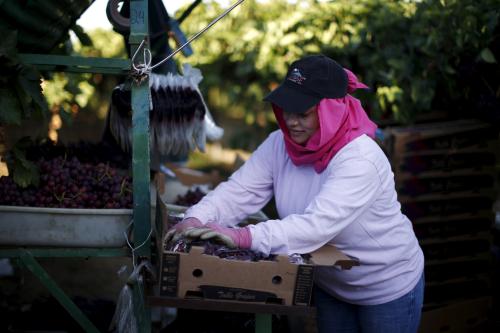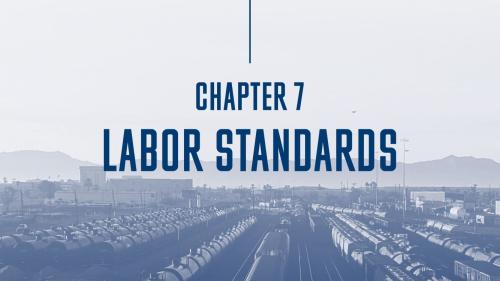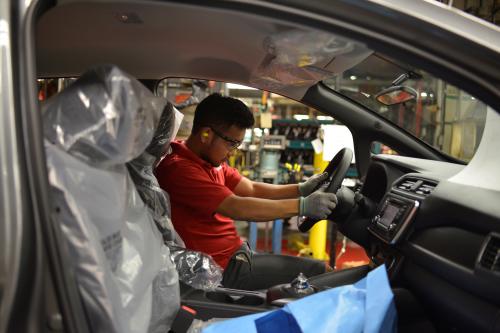This is a viewpoint from the USMCA Forward 2023 report where experts dive into the opportunities and complementary actions needed to build more integrated, resilient, and secure supply chains in North America.
 The protection of labor rights is central to sustainable and inclusive supply chains under the USMCA— wherever the work takes place. The USMCA offers new mechanisms to address the unfair competition created by the suppression of workers’ rights, so long as the abuses occur in Mexico. Yet there are serious violations of labor standards in the United States as well, and nowhere more than with the employment of migrants in U.S. agriculture exports. For the U.S. fairly and credibly to insist that firms in Mexico comply with basic labor standards, it must demand the same regarding the treatment of workers in its own traded industries.
The protection of labor rights is central to sustainable and inclusive supply chains under the USMCA— wherever the work takes place. The USMCA offers new mechanisms to address the unfair competition created by the suppression of workers’ rights, so long as the abuses occur in Mexico. Yet there are serious violations of labor standards in the United States as well, and nowhere more than with the employment of migrants in U.S. agriculture exports. For the U.S. fairly and credibly to insist that firms in Mexico comply with basic labor standards, it must demand the same regarding the treatment of workers in its own traded industries.
The supply chains for fruits and vegetables in USMCA countries cross and recross borders. Mexico and Canada are by far the largest importers of U.S. produce, to the tune of $4.7 billion in 2021. U.S. fruits and vegetables for export are harvested by migrants under conditions that violate core labor standards. Migrants work in the aspects of agriculture that are too difficult or too expensive to automate. They are paid wages below the minimum, exposed to pesticides and relentless heat, crowded in housing not fit for humans, and subjected to sexual harassment and violence. Most are from Mexico, either undocumented or— in numbers that have tripled in the past three years—present on H-2A temporary agricultural visas.
Critically, U.S. immigration law is structured in ways that coerce migrants into continuing to work
despite these violations of their rights, creating a climate ripe for forced labor. Undocumented workers can be deported at any time. Migrants on temporary visas can only remain in the country as long as they are working for the firm that sponsored them. If they are fired for reporting abuse, they are instantly deportable. Many carry crushing debt from the recruitment process, and are well aware that those who protest will be blacklisted from future opportunities. It is little surprise that few speak up.
In the past year, the U.S. has seen six labor contractors sentenced in Georgia and Florida for forced labor and human trafficking of migrant farm workers in the H-2A program. These cases shine a spotlight on the mechanisms of control used to keep migrants from coming forward when their rights are violated. The convicted labor contractors took the workers’ passports and their wages, deploying everything from threats of deportation to kidnapping and rape to keep them silent. This is only the leading edge of the cases in the pipeline, which in turn barely scratch the surface of the problem. Between 2015-2020, the U.S. National Human Trafficking Hotline identified over 3,200 H-2A visa holders in agriculture who suffered labor trafficking, defined as the “use of force, fraud or coercion for the purpose of subjection to involuntary servitude, peonage, debt bondage or slavery.”
The prevalence of migrant abuse in United States’ agriculture is a national shame. In practical terms, it should also worry the United States’s trading partners under the USMCA. Workers in these circumstances are much cheaper than workers who are free, underwriting the cost of the produce the U.S. exports. This is unfair competition. Yet while the USMCA’s most powerful and innovative tools for enforcing workers’ rights are trilateral on paper, in practice they point only south. For example, the Facility-Specific Rapid Response Labor Mechanism is designed in a way that makes it extremely difficult to trigger in the U.S., and in any case it excludes agriculture entirely.
The USMCA offers ways to address this issue—if only they are taken seriously. Article 23.8 requires that all three countries enforce migrants’ labor rights. Yet the U.S. government’s failure to take public action in the year and a half following the filing of a USMCA complaint about rampant sex discrimination in the H-2 visa program does not raise high hopes that the requirement will have teeth.
There is one more aspect of the USMCA that could apply here, so far unexplored. Article 26.3 requires all three governments to enact import bans on goods made with forced labor. The U.S. has already done so, as has Canada. Under its forced labor import ban, Canada could seize produce harvested by migrant workers in the U.S. under conditions of forced labor. When Mexico adopts a ban, it could do the same.
If this idea sends shudders through the U.S. government, there is much it could do to address the underlying problem. The U.S. could legalize undocumented farm workers and eliminate the requirement that ties H-2A migrants to a single sponsor. It could expand and enforce rules holding growers responsible for the exploitation that occurs during recruitment, which accounts for the debt migrants carry into the field. It could follow in Canada’s tracks and mandate that growers use the Mexican National Employment Service as their sole recruiter, not a perfect solution but surely better than the current system.
One way or another, it is time for USMCA partners to take the treatment of migrant workers seriously. In the U.S., just as in Mexico, labor costs that are artificially suppressed by worker abuse should have no place in trade.







Commentary
Unfair competition under the USMCA: The case of migrant workers on US farms
Tuesday, February 28, 2023